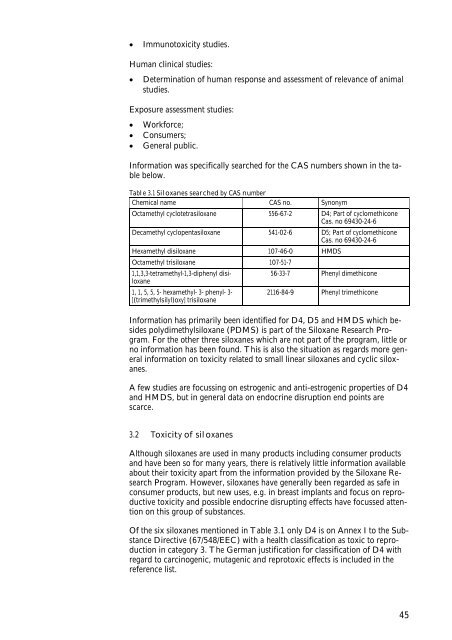No. 1031 - Miljøstyrelsen
No. 1031 - Miljøstyrelsen
No. 1031 - Miljøstyrelsen
You also want an ePaper? Increase the reach of your titles
YUMPU automatically turns print PDFs into web optimized ePapers that Google loves.
• Immunotoxicity studies.<br />
Human clinical studies:<br />
• Determination of human response and assessment of relevance of animal<br />
studies.<br />
Exposure assessment studies:<br />
• Workforce;<br />
• Consumers;<br />
• General public.<br />
Information was specifically searched for the CAS numbers shown in the table<br />
below.<br />
Table 3.1 Siloxanes searched by CAS number<br />
Chemical name CAS no. Synonym<br />
Octamethyl cyclotetrasiloxane 556-67-2 D4; Part of cyclomethicone<br />
Cas. no 69430-24-6<br />
Decamethyl cyclopentasiloxane 541-02-6 D5; Part of cyclomethicone<br />
Cas. no 69430-24-6<br />
Hexamethyl disiloxane 107-46-0 HMDS<br />
Octamethyl trisiloxane 107-51-7<br />
1,1,3,3-tetramethyl-1,3-diphenyl disiloxane<br />
56-33-7 Phenyl dimethicone<br />
1, 1, 5, 5, 5- hexamethyl- 3- phenyl- 3-<br />
[(trimethylsilyl)oxy] trisiloxane<br />
2116-84-9 Phenyl trimethicone<br />
Information has primarily been identified for D4, D5 and HMDS which besides<br />
polydimethylsiloxane (PDMS) is part of the Siloxane Research Program.<br />
For the other three siloxanes which are not part of the program, little or<br />
no information has been found. This is also the situation as regards more general<br />
information on toxicity related to small linear siloxanes and cyclic siloxanes.<br />
A few studies are focussing on estrogenic and anti-estrogenic properties of D4<br />
and HMDS, but in general data on endocrine disruption end points are<br />
scarce.<br />
3.2 Toxicity of siloxanes<br />
Although siloxanes are used in many products including consumer products<br />
and have been so for many years, there is relatively little information available<br />
about their toxicity apart from the information provided by the Siloxane Research<br />
Program. However, siloxanes have generally been regarded as safe in<br />
consumer products, but new uses, e.g. in breast implants and focus on reproductive<br />
toxicity and possible endocrine disrupting effects have focussed attention<br />
on this group of substances.<br />
Of the six siloxanes mentioned in Table 3.1 only D4 is on Annex I to the Substance<br />
Directive (67/548/EEC) with a health classification as toxic to reproduction<br />
in category 3. The German justification for classification of D4 with<br />
regard to carcinogenic, mutagenic and reprotoxic effects is included in the<br />
reference list.<br />
45

















